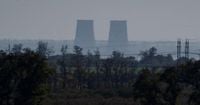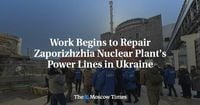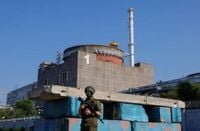On Saturday, October 18, 2025, a fragile calm descended over one of the most volatile front lines in Europe as repair crews began the delicate task of restoring power to Ukraine’s Zaporizhzhia nuclear power plant. After four tense weeks relying on backup diesel generators, the restoration effort—underpinned by special ceasefire zones—marks a rare moment of cooperation between Russian and Ukrainian forces, according to the International Atomic Energy Agency (IAEA).
The Zaporizhzhia facility, Europe’s largest nuclear power station with six reactors, has been a focal point of international concern since it was seized by Russian troops in the early days of Moscow’s full-scale invasion in February 2022. The plant, located near the embattled city of Enerhodar along the Dnipro river, has been disconnected from Ukraine’s power grid repeatedly throughout the war, but the latest outage—beginning September 23, 2025—was the longest yet. The blackout forced the plant to rely exclusively on diesel generators to cool its reactors and spent fuel, a situation the IAEA has repeatedly warned could end in disaster if backup systems fail.
“Restoration of off-site power is crucial for nuclear safety and security. Both sides engaged constructively with the IAEA to enable the complex repair plan to proceed,” IAEA Director General Rafael Grossi said in a statement posted to social media. The sentiment was echoed by Ukrainian Energy Minister Svitlana Grynchuk, who confirmed that Ukrainian specialists were actively involved in the restoration work. She emphasized, “Stable operation and connection with the Ukrainian power grid are fundamental to preventing a nuclear incident.”
The plant’s vulnerability has been a persistent worry for global nuclear safety experts. Although Zaporizhzhia is not currently generating electricity, it requires a constant supply of power to keep its six shutdown reactors and spent fuel pools cool. A loss of cooling could lead to fuel melting and potentially catastrophic radiation releases—a nightmare scenario for Ukraine and its neighbors. The IAEA has stressed that if diesel generators were to fail, “it could lead to a complete blackout and possibly causing an accident with the fuel melting and a potential radiation release into the environment, if power could not be restored in time,” as reported by the Associated Press.
The repair operation itself is the result of painstaking diplomatic efforts. Grossi held talks with both Kyiv and Moscow in late September, meeting Ukrainian Foreign Minister Andrii Sybiha at the Warsaw Security Forum and engaging in discussions with Russian President Vladimir Putin and Rosatom Director General Alexei Likhachev in Moscow. According to a European diplomat cited by AP, the IAEA’s proposal involved restoring external power in two phases, each requiring a 1.5-kilometer-radius ceasefire zone: first to repair the main 750-kilovolt Dniprovska line under Russian control, and then to fix the Ferosplavna-1 330-kilovolt backup line in territory held by Ukraine.
Both the Ukrainian energy ministry and the Russian-appointed management of the plant have confirmed the maintenance work. The Russian side noted that Russia’s Defence Ministry would play a key role in ensuring the safety of the repair crews. The plant’s management stated via Telegram that the repairs were possible thanks to “close cooperation” between the IAEA and Russia’s state nuclear corporation Rosatom. It’s a rare instance of coordination in a conflict otherwise marked by mutual recrimination—Kyiv and Moscow routinely accuse each other of attacks that endanger the plant and the wider region.
Ukrainian Energy Minister Grynchuk highlighted the extraordinary frequency of such crises, noting that “it was the 42nd time since the start of Russia’s full-scale invasion in February 2022 that power lines to the plant had to be restored.” The sheer number of incidents underscores the perilous position Zaporizhzhia occupies, both geographically and politically.
Meanwhile, the war’s broader violence shows no sign of abating. On the same night that repairs began, Russia launched three missiles and a staggering 164 drones against targets across Ukraine, according to the Ukrainian Air Force. Ukrainian forces managed to shoot down 136 of the drones, but not all attacks were thwarted. In the Zarichny district of Sumy, in northeast Ukraine, two women—ages 51 and 53—were injured when Russian drones struck a gas station, regional Governor Oleh Hryhorov reported. Russia’s Ministry of Defense, for its part, claimed its air defenses had shot down 41 Ukrainian drones overnight.
The political backdrop to the technical efforts at Zaporizhzhia has also grown more complex. The repair work began one day after a meeting between U.S. President Trump and Ukrainian President Volodymyr Zelenskyy at the White House, and two days after Trump reportedly spoke by phone with Russian President Vladimir Putin. While details of these discussions remain closely guarded, President Trump described the meeting with Zelenskyy as “very interesting, and cordial,” adding that he believed progress was being made toward ending the war. Talks included the potential provision of U.S. Tomahawk missiles to Ukraine, possibly in exchange for Ukrainian drones, though Trump expressed concerns that such a move could escalate the conflict. Russia, for its part, has not signaled any willingness to end hostilities, and a senior Russian diplomat recently denied any intention to restart the Zaporizhzhia plant.
Amid these high-level maneuvers, the IAEA’s efforts stand out as a beacon of pragmatic problem-solving. The agency’s proposal for phased repairs—requiring localized ceasefires and delicate cooperation between adversaries—may offer a template for future risk mitigation in war zones. Still, the situation remains fraught. Ukraine’s foreign minister has accused Russia of deliberately severing the external power line in an effort to link the plant to Moscow’s power grid, a charge Russia denies.
As the world watches, the restoration of off-site power at Zaporizhzhia is a stark reminder of the razor-thin margins separating safety from disaster in modern warfare. With the plant’s fate hanging in the balance, the success of this repair mission could prove decisive not only for Ukraine, but for the broader region’s security and environmental well-being. For now, the lights remain on—if only just—and the world breathes a tentative sigh of relief.


